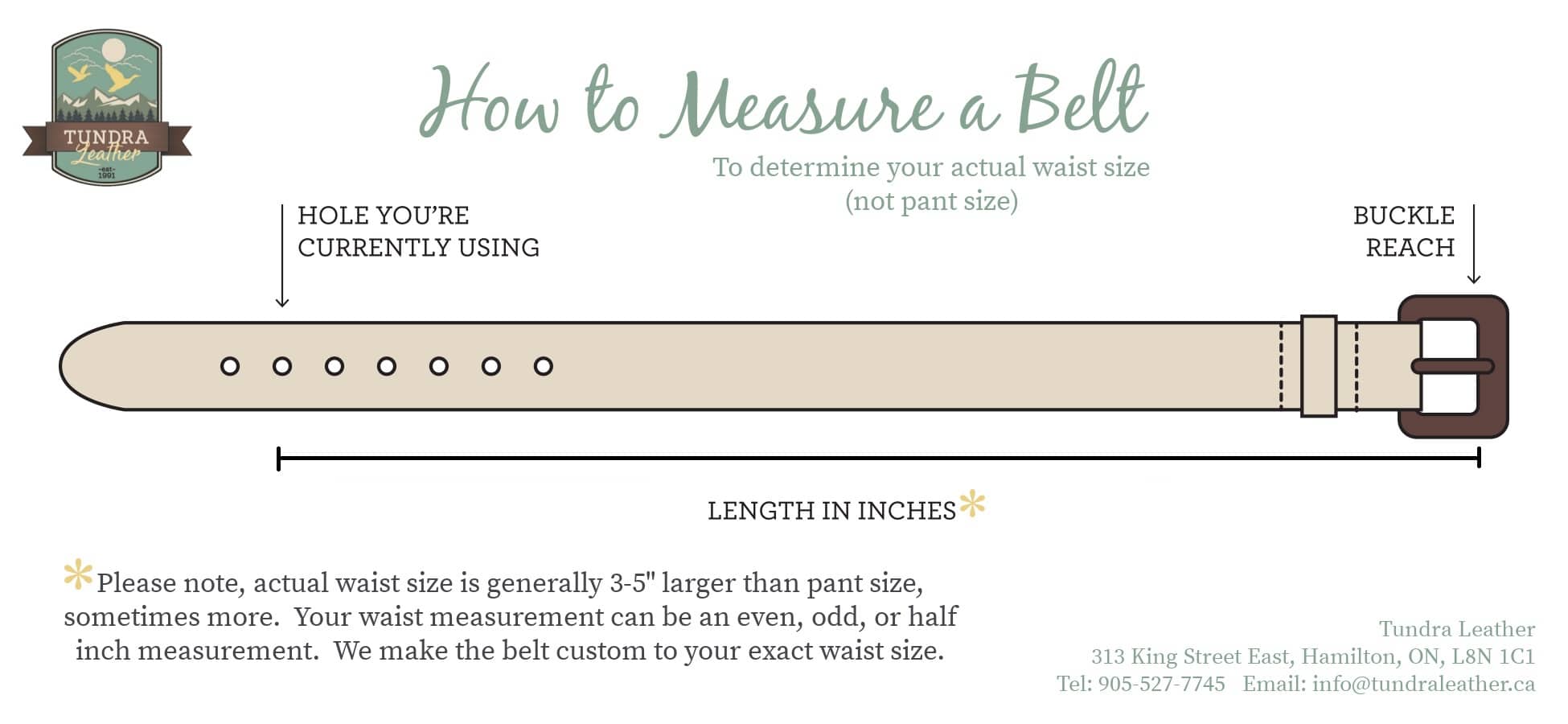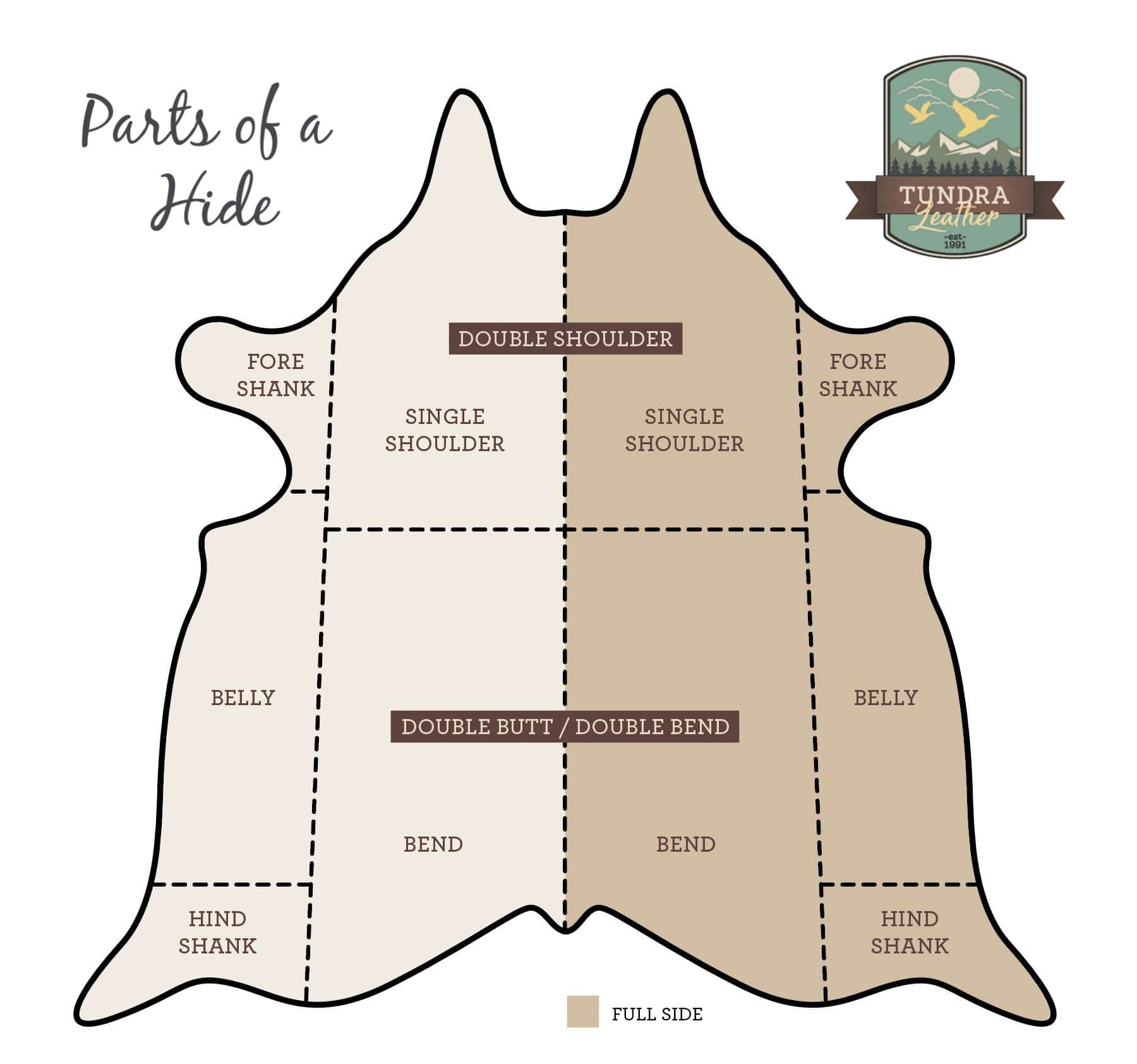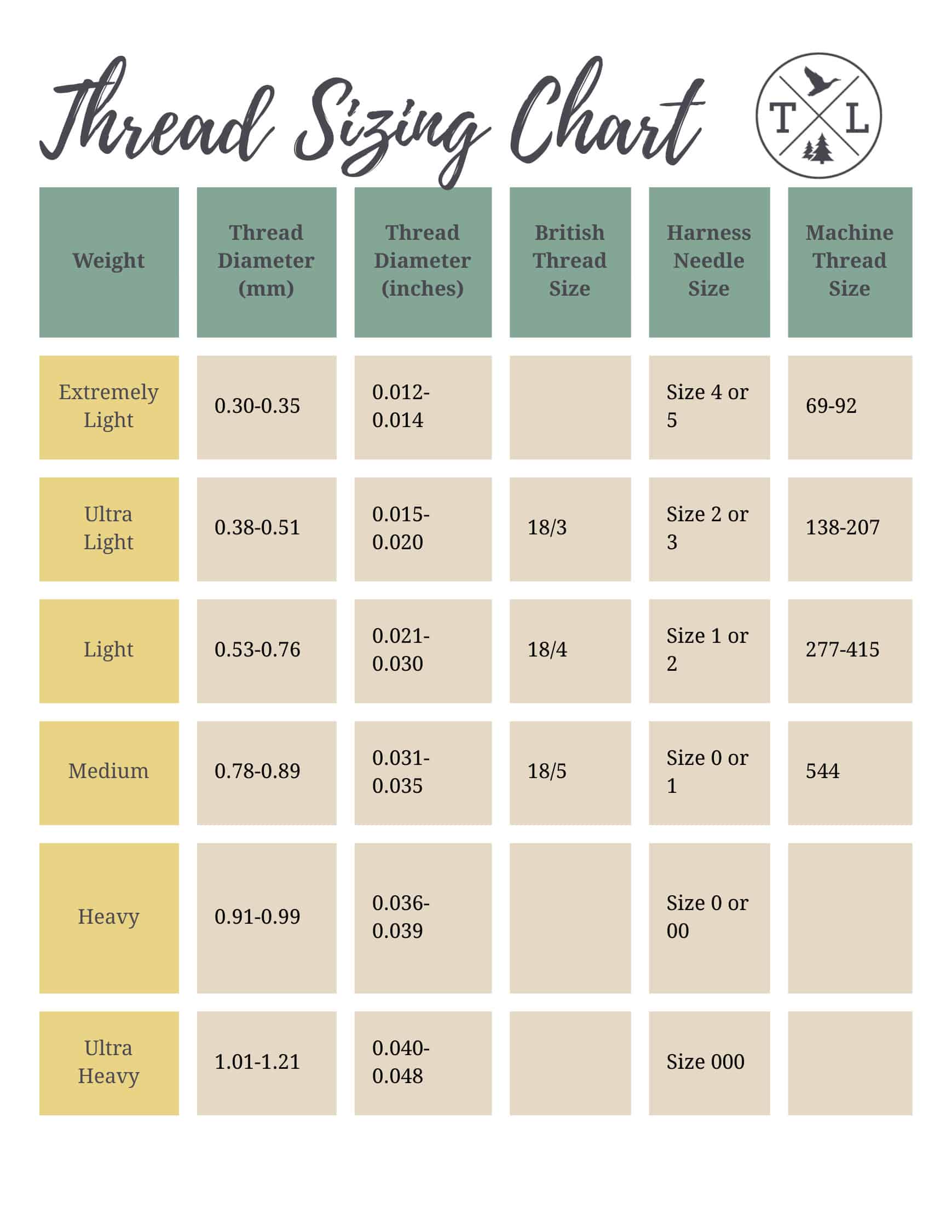Terminology
There are so many leatherworking terms out there… Below is a list that should help with leatherworking terms and phrases. If you’re still uncertain about specific leatherwork terminology, feel free to contact us!
Adhesives
Toluene based cements, poly-vinyl acetate, white glue, hide glue, and rubber cement.
Aniline Finish
A process of coloring skins, without a top finish. Only dyes are used to achieve the coloration. This process can only be used on the finest quality skins as all surface blemishes remain apparent.
Apron Splits
Soft, durable leather that has been split to expose the underneath layer. Without a natural grain, it is then sueded and dyed a pearl gray. Chrome tanned. Ideal for farrier aprons.
Back
The main portion of a hide, obtained by cutting off the two bellies.
Bellies
Feature softer, looser fibers than the top part of the hide. Vegetable tanned. Ideal for linings, dog collars, and knife sheaths.
Bi-Cast Leather
Bicast leather is made from split leather which is then laminated with a polyethylene top layer. It has been made available thanks to modern technology, which lets leather be split into a number of layers, at a reduced cost compared to natural leather. The layers used to make bicast leather are of very inferior quality, which, without the coating, may not be of any use at all.
Bison/Buffalo
Soft, supple leather. It has a lot of grain, texture, and character. Chrome tanned. Ideal for mitts, bags, moccasins, and pouches.
Bonded Leather
Also known as reconstituted leather is a term used for partially synthetic leather. It is a synthetic material made of varying types of plastic (generally polyurethane or vinyl) that may be spread over ground-up leather and other substances, mechanically processed to give the appearance of leather, but at reduced cost and with less wastage compared to natural leather. Examples of products that are most commonly constructed with different varieties of “bonded leather” are: books, diaries, art books, desk accessories, bags, belts, chairs, and sofas.
Bridle
Firm, rich-coloured leather with enough oils to withstand weather. Great feeling leather, which can be oiled for darker hues. Vegetable tanned. Ideal for tack items and fine pet products.
“English” Bridle
Strong, waxy, weather-resistant “English” bridle leather, which is the closest to bridle leather made in England. The best U.S. native steer hides are slowly vegetable tanned. These are not to be confused with authentic English bridle leather that’s tanned in England. Ideal for English and western tack, belts, harness parts, strirrup leathers, and pet pouches.
Butt
The part of the hide after the bellies and shoulders have been removed.
Chrome Oil Tanned
Beautiful, durable leather that has just the right amount of oil for a soft, supple feel. Idea of work chaps, saddle bags, and linings.
Chrome Tanned
Beautiful quality leather, which is consistent in colour and grade and offers a great yield. Idea for horse collars, liners, pouches, and bags.
Deer
Very supple, beautiful quality leather. Chrome tanned whole hides have little waste. Ideal for garments, gloves, native regalia, and personal leather goods.
Double Backs
A hard-to-find cut, double backs offer maximum yield with virtually no waste. Available in vegetable tanned natural strap or alum tanned lace leather. Ideal for belts, cases, holsters, lace, and linings.
Drum
A large vessel or vat used in the processing of the skins.
Drum Dyed
A process of coloration whereby the skins are fully immersed in a liquid dye solution in order to obtain desired color.
Emboss
A mechanical means of changing the normal grain of the skin.
Exotics
Refers to a number of unusual animal/reptile skins that are tanned primarily for the small leather good/accessory/shoe business (i.e. lizard, snake, crocodile skins, etc.)
Flank
The loose, thin side portion of the skins (the underbelly of the animal).
Garment
Beautiful leather is soft and supple and available in consistent colours. Chrome tanned. Ideal for garments, chaps, and saddle seats.
Gum Tragacanth
Gum Tragacanth is a water based, low volatile organic compound (V.O.C.), natural gum based edge slicking and burnishing compound for use on natural or colored veg-tanned leather. Produces a professional looking, smooth, shiny, burnished edge.
Flesh
The interfacing side of the skin as opposed to the outer portion of the skin.
Harness
Stuffed with heavy tallows for exceptional weight, thickness, ease of cutting and durability. Vegetable tanned. Ideal for work or show harnesses and saddlery.
Horse
Very durable and abrasion resistant. Chrome tanned for a soft feel, and made mostly for the gloving industry. Ideal for gloves, mitts, and garment use. Hose is sometimes vegetable tanned for a durable belt weight leather. Ideal for razor strops, gun holsters, etc.
Kangaroo
These skins are extra strong and durable with a soft, supple feel. Vegetable tanned. Ideal for braided whips, lacing on saddles and tack, or anywhere lacing is used.
Kipskin
Very clean piece of leather, which dyes and stamps beautifully. Vegetable tanned. Ideal for small leather goods.
Lace
Firm, non-stretching leather to be used where strength is essential. Alum tanned. Ideal for laces, linings, braided reins, or cinches.
Latigo
Soft, supple leather. Great for use on products in which strength and flexibility are needed. Choose from chrome vegetable retanned, vegetable tanned, or alum tanned. Ideal for tack, saddlery, and pet products.
Mill
Tumbling the skins in a large vessel to induce softness and other grain characteristics.
Moose
Soft and very durable. Sold in a variety of weights and colours. Chrome tanned. Ideal for mitts, moccasins, bags, etc.
Nap
The fibrous surface of suede.
Natural Veg Strap, Tooling, and Moulding Leather
Perfect leather for tooling, embossing, moulding, dyeing, and oiling. Uniformly absorbs dyes and oils. Dries to a firm, long-lasting shape. Vegetable tanned. Ideal for belts, tack, briefcases, holsters, and sheaths.
Nubuck
Buffed on the top grain with oil to produce “nap” for a matte, sueded look. Chrome tanned. Ideal for liners, chaps, saddle bags, messenger bags, and pouches.
Patent
Heavily finished leather with a highly lustrous baked enamel appearance. Available in both chrome and vegetable tanned. Ideal for show harnesses, bridle blinds, and housings.
Pig
There are so many different types of pig leather, that it’s difficult to explain without taking up too much space. Garment suedes, wallet interiors/linings, shoe and boot linings, etc. Virtually always chrome tanned.
Rawhide
Strong, firm, untanned cattle hide. Ideal for saddle horn wraps and covered stirrups.
Saddle Skirting
Moulds and forms to seat, and readily accepts tooling or embossing. Oils and dyes evenly for a nice, beautiful, uniform appearance. Vegetable tanned. Ideal for saddles, tooled and embossed products.
Shearlings
Beautiful quality sheepskins in a variety of thicknesses. Available in vegetable tanned and chrome tanned, in beautiful colours.
Sheep
Sheep are almost always chrome tanned. We stock deer tanned sheep, which are sheep skins tanned in exactly the same vats as deer skin. It becomes a less expensive version of deer skin. Ideal as a deerskin replacement.
Shoulders
This cut effectively utilizes the head and neck area for miminal waste and optimum use. Great cut for belt manufacturers. Vegetable tanned. Ideal for belts and craft items.
Skive
The process of reducing the thickness of leather.
Sole Bends
Taken from the best portion of the hide, this extra thick leather features a firm (hard) tannage, designed especially for shoe soles. Vegetable tanned. Ideal for shoe soles and weight lifting belts.
Split
A layer of skin that has been skived off by mechanical means.
Square Foot
The unit of measure of a skin by which all leathers are purchased from tanners by manufacturers.
Suede
Finished by budding the flesh side (opposite the grain side) to produce a “nap.” Chrome tanned. Ideal for show or work chaps, saddle seating, and moccasins.
Tallow
A hard fatty substance made from rendered animal fat, used in making candles, soap, and leather tanning.
Tannage/Tanning
The means of stabilizing the skin structure by chemical means.
Upholstery
Soft, supple leather is very strong and durable. Tanned in whole hides for little waste. Used in automotive and restoration upholstery, where large pieces of leather are desireable. Chrome tanned. Ideal for upholstery!
Veg Chrome Tanned
Firm, yet pliable piece of leather with a nice satin finish. Ideal for suspenders, liners, and pouches.
Weight
The term used for the measurement of the thickness of the leather. In Canada, this is often in ounces.
How to Measure a Belt
Use the diagram below to help you measure your favorite belt accurately. Pay close attention to the placement of the arrows, as they indicate the correct points for measuring waist size. Please avoid measuring the entire length of the belt. If you don’t have a belt to measure, simply use a measuring tape to measure your waist where you would typically wear your pants, and record the measurement in inches.
How to Protect Your Tools
All About Renaissance Wax
It’s a type of microcrystalline wax that we use to protect our metal tools. Waxes tend to last longer and protect better than other materials, such as oil. The wax will create a protective barrier between your tools and moisture/oxygen, which can do them damage (e.g. rust or oxidize). You’ll want to use this product on the metal tools (steel or brass) that you touch most with your hands. We use it often on head knives, pricking irons, creases, punches, bevelers, etc. To use, apply a thin coat of wax evenly over your tools, and then buff lightly with a soft clean cloth or a piece of sheepskin. You’ll need to re-apply every so often. If you’ve got a damp shop, you might consider applying every 2 months. If you’re in a more dry location, you could consider re-applying every 6-8 months. The small tin should last you a good long time.
We sell the 65 ml tins in our shop! Contact for details!
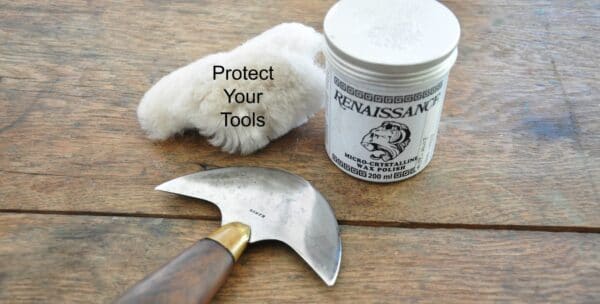
The Best Punch Pads
You spend a lot of money on your tools, and you want to protect them. But what’s the right punch pad? Are they all the same? Should I have more than one? We’re here to answer your questions with some quick tips for success!
Sharp Punches (round punches, strap end punches, oblong punches, etc.)
- You want to do all of this punching onto a rubber pad or a piece of UHMW (ultra high molecular weight) polyethylene. These pads will absorb the punch without doing any damage to the blade. You also want to make sure that your pad is on something sturdy, e.g. a piece of marble, or a really solid table
- Never do any punching on metal, glass, or marble. They’re not designed to absorb the punch, and will ruin the edge, even if you can’t see it right away
Chisels (the type meant to strike all the way through your piece of leather)
- We’ve found recently that the UHMW polyethylene pads sometimes do damage to lower quality chisels, and if you don’t have tons of money to spend on chisels, you still want to make them last as long as you can! For these, we use either a piece of rubber or a piece of (MDF) Medium Density Fibreboard/Hardboard
- One of the sweet benefits of rubber or MDF over the UHMW is that they won’t mark your work. Once you’ve punched many times into the UHMW, you’ll feel that the plastic becomes rough and has a tendency to scratch your work, especially those beautiful oil pull-ups/waxy finishes. The rubber/MDF will work really well, but also keep your work looking amazing.
- One benefit of the MDF over the rubber is that the MDF will help regulate your chisel depth when punching. The chisels will only go so far into the MDF and all of your holes will be the same size. Whereas with rubber, the harder you hit your chisel, the more your tool will go into the rubber, creating some small chisel holes and then some HUGE chisel holes
General Cutting (head knife, rotary knife, utility knife, etc.)
- For all of our general purpose cutting, our work table is covered in a large piece of UHMW, which works well (for years) for all types of cutting. A lot of people use Olfa Self-Healing mats as well, which are good, just not quite as long lasting.
Conclusions
We find it beneficial to have pieces of UHMW, rubber, and MDF punch pads around, for different jobs (different tools, different leather, etc.). We have small pieces of MDF available for sale in our shop. Contact us for details!
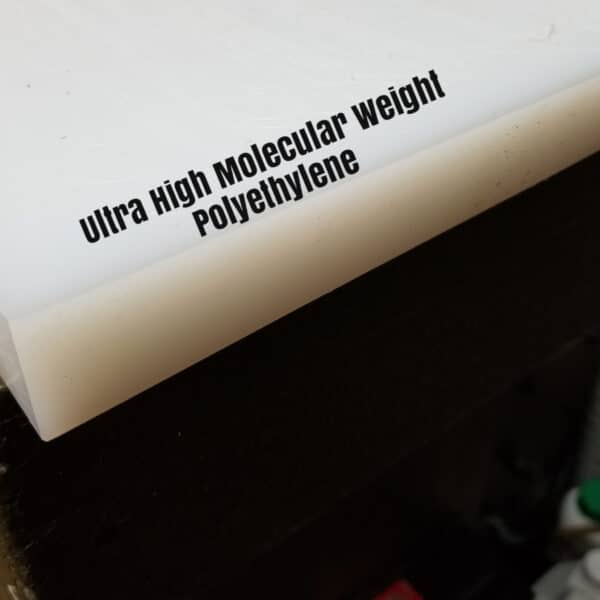
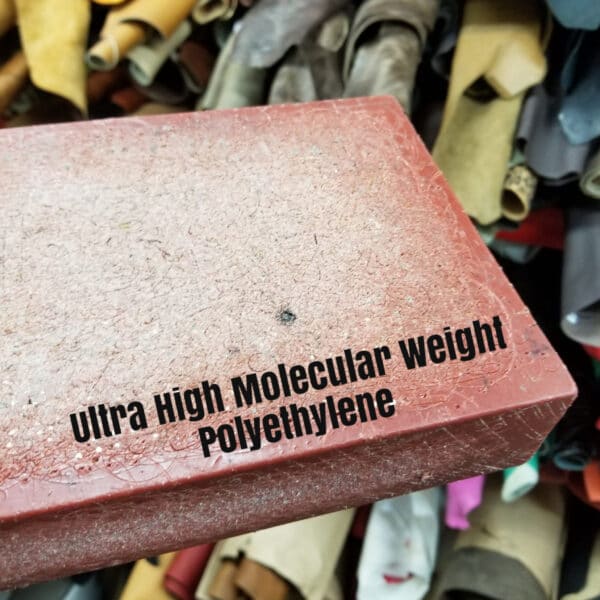
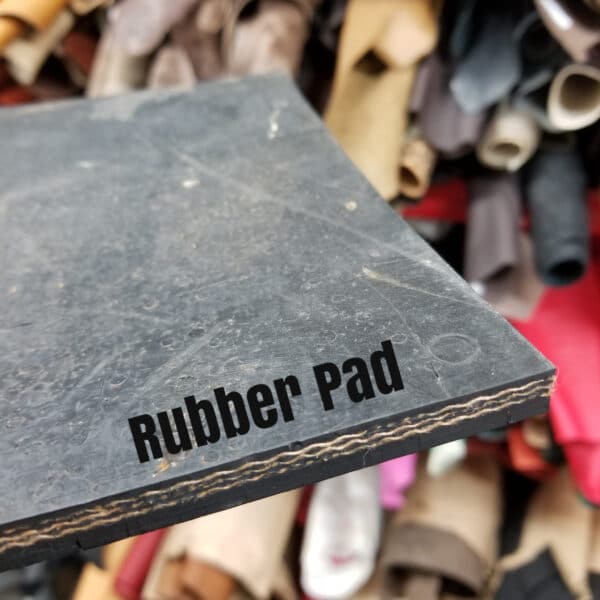
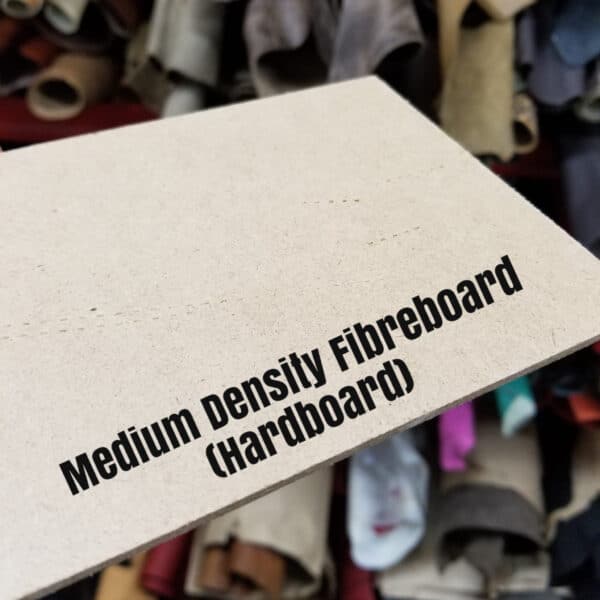
How to Set Copper Rivets
If you’re unfamiliar with copper rivets, they’re one of the strongest rivets you can use to hold two (or more) pieces of leather together. Here’s a list of the tools you’ll need, but they’re also listed in our video below:
- Leather
- Copper Rivets & Burrs
- Copper Rivet Setter (must match your size of copper rivets, e.g. #12, #9, etc.)
- 5 oz. piece of leather ¾” x 1 ½” or similar (this will be your spacer gauge)
- Mallet or Maul
- Ball Peen Hammer
- Side Cutters or End Cutters
- Two piece rivet setter
Drop us a line if you have any questions at all! We’re happy to help!
How to Burnish Edges of Leather
This video will show you how to burnish the edges of our leather products (belts, cases, etc.). As mentioned in the video, this is for vegetabled tanned leather only (natural, bridle, and latigo). Any chrome tanned leather is best tackled using an acrylic edge agent (also mentioned in video).
This video will show you how to burnish the edges of our leather products (belts, cases, etc.). As mentioned in the video, this is for vegetabled tanned leather only (natural, bridle, and latigo). Any chrome tanned leather is best tackled using an acrylic edge agent (also mentioned in video).
Bridle vs Harness Leather
“English” Style Bridle
This leather is strong, waxy and weather resistant, with a specific blend of greases and tallows (similar to true English Bridle Leather). It is drum dyed for true dye penetration throughout the piece. It is tanned in the United Stages, using U.S. hides. It’s excellent for horse gear, as well as wallet, and small leather goods. It will get a lovely patina over time.
Bridle Leather
- Made with specific blend of waxes, oils, and tallows
- Slight matte finish
- Natural hide characteristics still show through
- More rigid
- Strong and weather resistant
Traditional Harness
Using an exclusive bland of waxes, oils and tallows, the leather is “hot stuffed” to bring out their inherent beauty. Through a traditional process called jack glazing, oils are brought to the surface to create a glossy finish that never masks the leather’s natural grain. It is tanned in the United States. As a result, Traditional Harness is ideal for equestrian gear, yet, when split to a lower weight as seen here, it’s equally suitable for small leather goods such as wallets, card cases, etc.
Harness Leather
- Made with specific blend of waxes, oils, and tallows
- Jack glazed for a very glossy/waxy finish
- Natural hide characteristics still show through
- More supple feeling
Leather Straps for Shelving
When it comes to hanging shelves, the devil is in the details. While there are plenty of options out there for creating the perfect shelf, ensuring that it’s hung properly is key to both its function and aesthetic. From choosing the right thickness and type of wood to selecting sturdy hardware and adding durable touches like full-grain leather, every step matters. With the right materials, a little know-how, and some essential safety tips, you’ll be able to create a shelf that’s both strong and beautiful.

